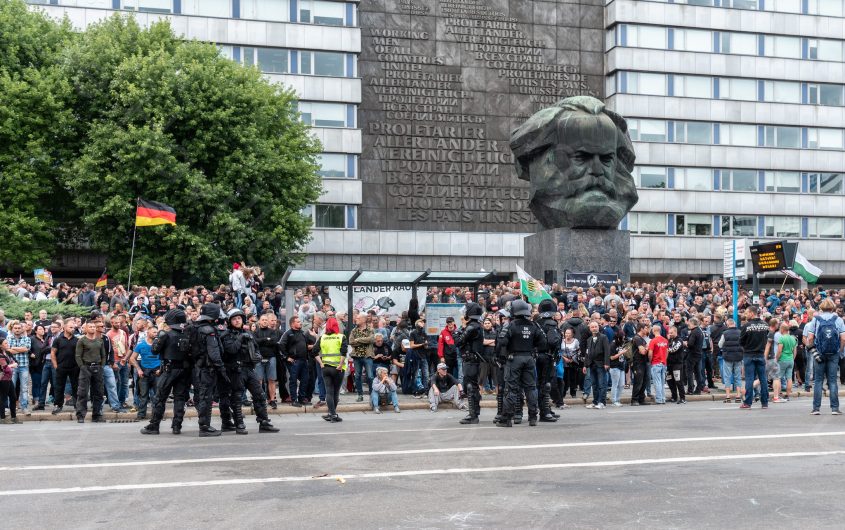
De Havilland via Flickr
The Chemnitz/Charlottesville Era and Readjusting What to Expect of Government

Alexandra Bloomfield
Development and External Relations Associate
Alexandra Bloomfield is the Development and External Relations Associate at AICGS. Prior to joining AICGS, Ms. Bloomfield worked as a sales and marketing professional for several German companies in the United States and abroad, including Siemens AG and NOMOS Glashütte. She recently moved back to the United States from Munich in September 2017, after living in Germany for five years.
She holds an MA in History from the Universität Konstanz, Germany, where her research focused on early modern transatlantic history; and a BA in History from the University of Richmond, Virginia. She has also participated in additional study abroad programs with Universität Konstanz and Universität Wien.
__
After the recent week of protests in Chemnitz, comparisons to the events of Charlottesville’s 2017 “Unite the Right” rally have abounded. And with good reason. Both events forced their respective societies to examine (what they thought were) the moral norms of the majority challenged by the protests, and the response of their respective governments.
Der Spiegel published an essay two years ago titled “What’s Wrong With Saxony?” The state, where Chemnitz is located, is the birthplace of the racist and Islamophobic group PEGIDA, formed a year before the refugee crisis hit its fever pitch in 2015. Indeed, something has been fomenting fear and hatred of foreigners in the state since before the Wall fell. According to this and another essay, a mixture of a proud statehood history, a victim mentality after rigorous World War II bombings, the housing segregation of immigrants from the rest of the population in East Germany, and general racism unchecked by Saxon leadership could all be to blame.
Could a similar comparison be drawn to Charlottesville—looking at both the immediate lead-up to the march and further back into history? Virginia was home to the capital of the Confederacy during the Civil War, a government that fought to keep the institution of slavery in place. It has been well documented that statues glorifying figures from the Confederate Army were erected not so much in the immediate aftermath of the Civil War, but instead many decades later during the Jim Crow and Civil Rights eras to scare Black Americans. The white supremacist organizers of “Unite the Right” claimed to be protesting the removal of Confederate statues throughout the country. The mixture of lingering post-Civil War bitterness and genuine disregard for Black Americans as fellow citizens is not unlike Saxony’s alleged ignorant pride or refusal to integrate with foreign-born people.
With such tell-tale signs that all was not equal in society, how were Germans and Americans caught so off-guard by Chemnitz and Charlottesville?
With such tell-tale signs that all was not equal in society, how were Germans and Americans caught so off-guard by Chemnitz and Charlottesville? For Chemnitz, the answer seems to be ambivalence and passiveness. Multiple newspaper articles have asked, has Chemnitz been too tolerant of these sentiments for too long, thinking nothing was going to happen? One journalist notes, “The citizens of Chemnitz want nothing to do with right-wing radicals—their skepticism of foreigners, however, is expressed with an openness that is unusual elsewhere.” Combining widespread criticism of the Saxon police’s sluggishness in responding to the far-right protest in Chemnitz with the unsettling news that a government employee was the one who leaked the arrest warrant of the two refugees accused of murder on Facebook, it may be worth exploring whether (and if so, how) the German government’s prior actions have been effective in fighting the rise of right-wing extremism.
Naturally, those in Berlin issued stern rebukes—but some rebukes took their time. Chancellor Angela Merkel’s remarks directly into a camera first came on September 5, ten days after the protests began, “We saw pictures from there that clearly showed hate and innocent people being chased. You have to show your disapproval of that.” It was a not a particularly strong condemnation. Indeed, she curtly ended her remarks with, “And with that, everything is said.” It almost sounds as if the obligatory condemnation of the “hate” is all that is needed as a response from Germany’s leader. Her remarks via government spokesperson on August 28 were harsher. An immediate, in-person denunciation might have carried more gravitas.
Interior minister Horst Seehofer—whose CSU party has clashed with Merkel on immigration tactics—placed partial blame for the Chemnitz protests on poor communication among German authorities. Had the Iraqi man accused of stabbing Daniel Hillig to death been deported in a timely matter (which would have happened if the system had worked as it was supposed to), then neither the death nor the protests would have happened. The proposed solution? Deal with migrants better. German foreign minister Heiko Maas (SPD) seemed to be the official to come out most strongly in an interview with German paper Bild Am Sonntag: Germans can no longer just talk theoretically about the ideals of liberal Western society like tolerance. They must “get up off the sofa and speak up.” Maas’ comments are a call to action, but hasn’t Germany heard this call before? After the formation of PEGIDA four years ago? After the revolts of the 1960s? After World War II? Again, it would be worthwhile to further examine the German government’s initiatives at both a national and more regional level to combat the ugly sentiment that led to the Chemnitz protests.
Compare this all to the reaction of President Donald Trump, who first condemned the violence in Charlottesville as something propagated by people “on many sides.” After significant backlash to the lukewarm comments, President Trump came back—allegedly begrudgingly—a few days later to specifically decry the actions of “bad” white supremacists, whose actions in the course of the Charlottesville protests killed counter-protestor Heather Heyer. The counter-protestors had not killed anyone, yet the president seemed to equivocate the protestors and counter-protestors as equal in causing violence (“You had a group on one side that was bad. You had another group on the other side that was also very violent.”) but also as equal in moral fiber (“But you also had people that were very fine people, on both sides.”). While one may gripe at the effectiveness of Chancellor Merkel’s brusque remarks, she certainly did not shy away from designating the group clearly in the wrong in Chemnitz.
While one may gripe at the effectiveness of Chancellor Merkel’s brusque remarks, she certainly did not shy away from designating the group clearly in the wrong in Chemnitz.
Interestingly, the United States government has been rather silent on Chemnitz. The speculation as to why could go off on many tangents—wanting to avoid comparisons to Charlottesville and the government’s poor response; or maybe, the Trump administration, battling the publication of another tell-all book about White House scandals, simply did not deem it important enough.
At this year’s attempt at a “Unite the Right 2” rally in Washington, DC, only a handful of far-right extremists showed up and were far out-numbered by counter-protestors. The same might not be said for Chemnitz, where multiple sources report that the angry mob often outnumbered counter-protestors. Although anecdotal, a young German man’s interview with The Daily Beast, during which he described himself as “torn” because he was disgruntled at the state of German leadership, can lead an outside observer to pessimism. He “spoke casually about the Lügenpresse (lying press)” a term often co-opted by neo-Nazis because it originated from the actual Nazis. Americans may easily recognize this as a version of President Trump’s favorite divisive phrase “Fake News.” It is possible that Germany and the United States entered an era in which the governments’ abilities to identify, handle, and quash xenophobic, racist, Islamophobic ideology need to be revisited.







